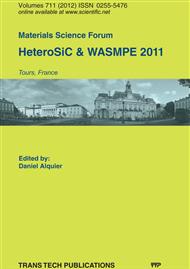[1]
H. K. Seong, H. J. Choi, S. K. Lee, J. Lee, D. J. Choi, Optical and electrical transport properties in silicon carbide nanowires, Appl. Phys. Lett. 85 (2004) 1256.
DOI: 10.1063/1.1781749
Google Scholar
[2]
M. Bechelany, A. Brioude, P. Stadelmann, G. Ferro, D. Cornu, P. Miele, Very long SiC-based coaxial nanocables with tunable chemical composition, Adv. Funct. Mater. 17 (2007) 3251.
DOI: 10.1002/adfm.200700110
Google Scholar
[3]
N O V Plank, M A Blauw, E W J M van der Drift, R Cheung, The etching of silicon carbide in inductively coupled SF6/O2 plasma, J. Phys. D: Appl. Phys. 36 (2003) 482.
DOI: 10.1088/0022-3727/36/5/310
Google Scholar
[4]
G. Cunge, R. L. Inglebert, O. Joubert, L. Vallier, N. Sadeghi, Ion flux composition in HBr/Cl2/O2 and HBr/Cl2/O2/CF4 chemistries during silicon etching in industrial high-density plasmas, J. Vac. Sci. Technol. B 20 (2002) 2137.
DOI: 10.1116/1.1511219
Google Scholar
[5]
F. A. Khan and I. Adesida, High rate etching of SiC using inductively coupled plasma reactive ion etching in SF6-based gas mixtures, Appl. Phys. Lett. 75 (1999) 2268.
DOI: 10.1063/1.124986
Google Scholar
[6]
Masakazu Kanechika, Noriaki Sugimoto, Yasuichi Mitsushima, Control of shape of silicon needles fabricated by highly selective anisotropic dry etching, J. Vac. Sci. Technol. B 20 (2002) 1298.
DOI: 10.1116/1.1484100
Google Scholar
[7]
D. A. Zeze, R. D. Forrest, J. D. Carey, D. C. Cox, I. D. Robertson, B. L. Weiss, S. R. P. Silva, Reactive ion etching of quartz and Pyrex for microelectronic applications, J. Appl. Phys 92 (2002) 3624.
DOI: 10.1063/1.1503167
Google Scholar
[8]
Dirk Sander, Wulf Wulfhekel, Margrit Hanbücken, Serge Nitsche, Jean Pierre Palmari, Frédéric Dulot, François Arnaud d'Avitaya, André Leycuras, Preferential carbon etching by hydrogen inside hexagonal voids of 6H-SiC (0001), Appl. Phys. Lett. 81(2002) 3570.
DOI: 10.1063/1.1519962
Google Scholar


